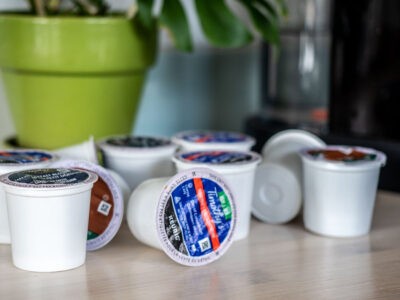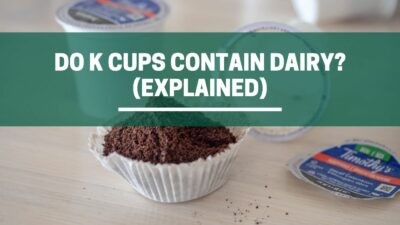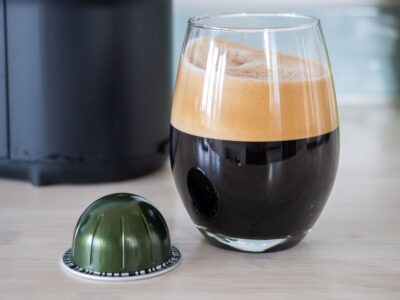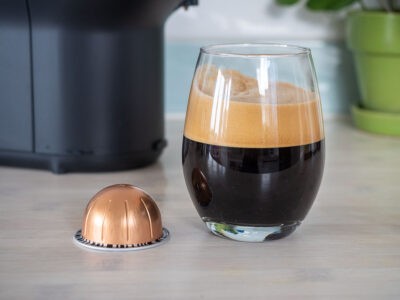Coffee 101, Recycling Guides
How To Use Coffee Grounds As Fertilizer (8 Ways)
Using coffee grounds as fertilizer is an eco-friendly way to repurpose waste and improve soil health.
They’re rich in nutrients, which keeps your garden’s mineral count in check and improves your soil’s water drainage and holding capacity. They also boost nitrogen, deter pests, and turbo charge wrom life.
In this article, I’ll share ways you can use grounds to enhance the health of your growing media.
Why Listen To Us? Well, because we KNOW coffee! In fact, we make our own coffee, coffee machine cleaners, and reusable capsules which we've sold to over 41 countries. Our team ouf experts include Tristan (an engineer), Claire (a food writer) and Richy (a barista). So, whether you're looking for a recipe or repair guide, we've got you covered 💚
Table of Contents
TLDR; How To Use Coffee Grounds As Fertilizer
Used coffee grounds are an excellent addition to your garden.
When added to compost, coffee grounds help balance the carbon-to-nitrogen ratio, resulting in richer compost. They improve soil drainage by creating pore spaces and aerate the soil by allowing oxygen to reach plant roots. When vermicomposting, they enrich worm castings. If you practice 100% organic gardening, spent grounds reduce the need for synthetic chemicals.

Different Ways You Can Reuse Coffee Grounds In Your Garden
1. Using coffee grounds as mulch
Being an organic matter, coffee grounds work exceptionally well as mulch. They have a fine texture, which creates a protective layer on the soil. This helps retain moisture and suppress weed growth. But when applied in excess, grounds can create an impermeable layer that repels water.
Because of this, they’re best mixed with other ingredients like wood chips or leaves. Alternatively, you can sprinkle them lightly onto the soil and rack them in.
2. Using coffee grounds as fertilizer
If you’re tired of spending hundreds of dollars on organic fertilizer, you can take advantage of this free organic resource. Coffee grounds are an excellent source of nitrogen and essential minerals, like phosphorus, potassium, and copper, which your plants need for healthy growth. Sprinkle spent grounds around your plants and lightly mix them into the soil.
3. Coffee grounds as natural pesticide
Compounds found in coffee, like caffeine and diterpenes, are toxic to insects, making coffee grounds ideal to repel pests. You can apply grounds sparingly in your garden to keep them away from your precious plants.

Which Plants Are Coffee Grounds Good For?
Coffee grounds are particularly beneficial for plants that prefer slightly acidic soil, like:
- Rose
- Azaleas
- Beets
- Radishes
- Tomatoes
- Hibiscus
If you’ve got a lot to go around, you can feed them to acid-loving plants like:
- Sweet potatoes
- Broccoli
- Blueberries
- Carrots
- Rhododendrons
Which Plants Shouldn’t You Try This With?
Plants that prefer alkaline soil may not thrive when you add grounds as a soil amendment. Examples include:
- Asparagus fern
- Geranium
- Potatoes
- Lavender
- Rosemary
- Chinese mustard
- Italian ryegrass
Caution: Coffee Grounds Around Cats And Dogs
Coffee grounds contain caffeine, which can be detrimental to pets. When ingested in large quantities, it can cause restlessness, agitation, vomiting, excessive panting, and seizures. Keep your pets away from areas where you’ve applied coffee grounds, or avoid adding them in places they frequent.

How To Use Coffee Grounds As Fertilizer (8 Ways)
✔️ 1. Adds nitrogen to compost
Coffee grounds are nutrient-rich. They contain about 2% nitrogen, 0.3% phosphorus, and 0.3% potassium. They also comprise trace minerals like magnesium, and copper, which help replace any nutrients extracted by plants. When you add grounds to your compost, the nitrogen is slowly released over time with the help of microorganisms. Once the compost matures, you can use it to nourish your garden for lush green foliage.
✔️ 2. Can deter slugs and snails from plants
It’s believed sprinkling coffee grounds around your plants creates a barrier that slugs and snails find repulsive. The rough texture of the grounds and the caffeine content act as deterrents. You can spread a thin layer of grounds around plants and reapply them after rain or watering, as they can lose their effectiveness over time.
✔️ 3. Use coffee grounds to improve soil drainage
When used in moderation, coffee grounds can improve the texture and structure of your soil by creating pore spaces in the soil. This allows excess water to drain away more efficiently, especially in clay or compacted soils.
✔️ 4. To help aerate the soil
Coffee grounds can create air pockets, allowing oxygen to reach plant roots more easily. This increased airflow enhances nutrient uptake.
✔️ 5. Improves soil water retention
Coffee grounds can absorb and hold water. This provides a steady supply of water to the plants, especially during dry periods.
✔️ 6. Can act as a cat repellent
Cats are said to dislike the aroma of coffee and tend to avoid areas where coffee grounds are present. Add grounds around specific areas you want to protect.
✔️ 7. Promotes good worm population
If you have a worm composting system, coffee grounds can be a valuable addition. Worms enjoy feasting on grounds, but they’re even more fond of the bacteria that break down the organic matter. This enriches their castings with nutrients, creating a rich soil amendment for your garden.
✔️ 8. Reduces waste and reduces chemical use
Heaps of spent grounds end up in landfills. By reusing your grounds, you can contribute to waste reduction. Also, if you practice 100% organic gardening, coffee grounds might be your next best friend. They provide much-needed nutrients your plants need to thrive, which minimizes the need for synthetic chemicals that get released into the environment.

How Not To Use Coffee Grounds As Fertilizer
Coffee grounds are clearly a gardener’s companion. But, do they have limitations? Here are the negative effects they can have on your soil and plants.
✖ 1. Can form a dense barrier over soil
Coffee grounds are finely textured. When used in excess, they clump together and form a dense barrier over the soil surface. This can hinder water and air flow, resulting in poor root development. To avoid suffocating the soil, mix grounds with other organic material or spread them thinly as a top or side dressing.
✖ 2. Inhibits seedlings from growing
The coffee ground’s caffeine and chlorogenic acid (CA) content restricts the germination of seeds and the growth of seedlings. Avoid adding grounds to young plants.
✖ 3. Caffeine can suppress root growth
Coffee grounds are a rich source of caffeine. Adding grounds directly to plants can stunt root development because it prevents their uptake of water and nutrients. This can result in leaf yellowing and defoliage.
A study of different plants–broccoli, violas, and many others, found plant growth was impeded by about 6 months to a year when coffee grounds were added as a soil amendment. This was mainly attributed to the plants’ toxic stress response from caffeine, tannins, and polyphenols. Also, microorganisms used a small amount of nitrogen to break down organic matter, which depleted the nutrient available to plants.
✖ 4. May kill off earthworms in compost
Earthworms require a balanced diet. If you feed earthworms 100% coffee grounds, it can throw off their nutrient intake and in the worst-case scenario, kill them. It’s better to add 20-30% spent grounds to your compost. This translates to 7cm (3 inches) of grounds for every 25 cm (10 inches) long bucket.
✖ 5. Anti-bacterial properties can destroy good bacteria in soil
Coffee grounds have antimicrobial properties, which can disrupt the balance of beneficial bacteria in the soil. Apply grounds in moderation to maintain a healthy microbial community.
✖ 6. Used coffee grounds are not acidic
Contrary to popular belief, used coffee grounds are not acidic. Most of the acid is water soluble so it ends up in brewed coffee, leaving the ground’s pH neutral (5.5 to 6.8). It’s not ideal to add them to acid-loving plants because it can hinder their growth. Rather add them to crops that prefer slightly acidic to neutral soil.
3 Tips For Using Coffee Grounds For Plants
Compost coffee grounds before use
Composting breaks down coffee grounds, allowing for a gradual release of nutrients into the soil. This promotes healthier and more sustained growth. It also improves the growing media’s overall structure, drainage, and water-holding capacity.
Use spent coffee grounds instead of fresh
Fresh coffee grounds are more acidic, which may have negative effects on plants that prefer slightly acidic to neutral soil. Used coffee grounds have lower acidity, making them a safer choice for most plants.
Create a liquid fertilizer
A liquid fertilizer ensures nutrients are readily available for plant roots to absorb while preventing density and texture problems. This is especially true for houseplants. To create a liquid fertilizer, soak spent coffee grounds in water for a few days. You can dilute the liquid with a coffee ground-to-water ratio of 1:2 before applying it to your plants.
Watch: This video gives some tip on using coffee grounds in your garden
Final Thoughts And Recommendations
Coffee grounds are an excellent way to maintain a healthy garden ecosystem. But the key is to use them in moderation. Because they’re finely textured, it’s best to sprinkle them lightly onto your growing media to prevent water and air flow problems. If you want to harness the organic matter’s potential, add them to your compost pile. The bacteria and fungi will break down the grounds into readily available nutrients for your plants to create a thriving garden.
Frequently Asked Questions
Q. Are coffee grounds safe for basil and other herbs?
Yes, when used in moderation, coffee grounds are safe to use for basil and other herbs. Just don’t overdo it.
Q. Can coffee grounds be used as a cat repellent?
Cats are said to dislike the aroma of coffee and tend to avoid areas where coffee grounds are present. Add grounds around specific areas you want to protect. Note, the effect will wear off as the coffee breaks down so you’ll want to top up every 2 – 4 weeks.
Q. Where to get coffee grounds to use in my garden?
You can collect coffee grounds from Starbucks. The outlet has a “Grounds for Your Garden” program offered on a first come first serve basis. If there isn’t one nearby, contact your local coffee shop and ask for a bag of used grounds. My local cafe leaves their ground in bags at the front door, so you can just grab them on your way out – easy!
Q. Should I use fresh coffee grounds or used coffee grounds?
Used coffee grounds are ideal because they have lower acidity, making them a safer choice for most plants. It’s also a massive waste of fresh coffee. We suggest you only use used coffee grounds in your garden.








